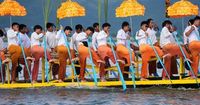On the misty morning of September 26, 2025, Myanmar’s Inle Lake transformed into a vibrant stage of tradition, spectacle, and spiritual devotion. Against a breathtaking backdrop of soaring, cloud-capped mountains, the annual Phaung Daw Oo Pagoda Festival reached its crescendo as teams of rowers—sometimes as many as a hundred to a boat—propelled long, decorated wooden vessels across the sparkling waters. The lake, nestled in southern Shan state and famed as Myanmar’s second-largest freshwater expanse, was alive with the rhythmic splash of oars and the cheers of hundreds of waterborne spectators who had gathered for this singular event.
According to the Associated Press, the boat races are more than just a thrilling competition; they are the heartbeat of one of Myanmar’s most important Buddhist religious celebrations. The Phaung Daw Oo Pagoda Festival, stretching over more than two weeks, draws people from all walks of life—locals and visitors alike—who crowd onto boats and jostle for the best vantage points along the lake’s edge. The festival, with its blend of sacred ritual and exuberant fun, showcases a unique facet of Myanmar’s cultural tapestry.
But what truly sets these races apart isn’t just the scale or the setting. It’s the rowing itself, performed in a style found nowhere else in the world. Here, the crews—members of the Intha ethnic minority—stand upright at the edge of their boats, balancing on one leg while wrapping the other leg around a single oar. With a graceful, almost dance-like motion, they propel their vessels forward, their synchronized movements a testament to strength, agility, and above all, coordination. The sight is mesmerizing: dozens of rowers, clad in traditional attire, moving as one over the shimmering lake, their boats gliding past lush, green hills and the occasional floating garden.
As reported by AP, the teams competing in these races are no small groups. Each boat can carry between 25 and 100 rowers, all working in perfect harmony. The boats themselves are long and narrow, their sides adorned with intricate designs and vibrant colors, further enhancing the festive atmosphere. Spectators—many perched on their own small boats—cheer on their favorite teams, waving flags and calling out encouragement as the rowers surge ahead.
The festival’s roots run deep. Phaung Daw Oo Pagoda, perched on the edge of Inle Lake, is home to four sacred Buddha images. Each year, these images are carefully lifted from their shrine and placed on an ornate barge, whose bow is shaped like the mythical Karaweik bird and gilded in gold. The barge, accompanied by a flotilla of boats, makes a grand procession around the lake, stopping at 21 villages so that people can pay homage. This journey is the spiritual heart of the festival, drawing pilgrims from across the country and reinforcing the deep connection between the lake, its people, and their Buddhist faith.
Yet, for many, the boat races are the highlight. The competition is fierce but friendly, with teams training for months in advance to perfect their technique. The races are as much about community pride as they are about individual skill. Villages along the lake field their own teams, and a win brings honor not just to the rowers, but to their entire community. It’s a point of local pride and a way to celebrate the unique heritage of the Intha people, whose lives have been intertwined with the lake for generations.
“It’s a unique display of strength, agility and above all, coordination,” noted the Associated Press, capturing the essence of the event. The combination of physical prowess and cultural tradition is on full display, as rowers navigate their boats with precision and grace, often in challenging conditions. The weather can be unpredictable, with sudden mists rolling in from the surrounding mountains, but the races go on, undeterred.
Waterborne spectators, many of whom have traveled hours to be there, add to the excitement. Some sit quietly, hands clasped in prayer as the sacred images pass by; others are more boisterous, laughing and shouting as the boats race past. The atmosphere is electric, a blend of reverence and revelry that’s rare to find elsewhere.
The festival is also a photographer’s dream. AP photo editors curated a gallery of images showcasing the spectacle: rowers silhouetted against the rising sun, boats cutting through the morning mist, and crowds of onlookers lining the lake’s edge. Each photograph tells a story—not just of competition, but of a community coming together to celebrate its faith and its way of life.
For those unfamiliar with the region, Inle Lake is a marvel in its own right. Stretching over 44.9 square miles, the lake is home to floating villages, markets, and gardens, all built on bamboo stilts or floating rafts. Life here moves at its own pace, dictated by the rhythms of the water and the changing seasons. The Phaung Daw Oo Pagoda Festival is the highlight of the year, a time when the lake’s scattered communities unite in a shared celebration.
Despite the joy and pageantry, the festival faces its share of challenges. Political and economic uncertainties in Myanmar have sometimes cast a shadow over public gatherings, but the resilience of the local people shines through. The festival endures, adapting to changing times while preserving its core traditions. For many, it’s a symbol of hope and continuity—a reminder that, even in turbulent times, culture and faith can bring people together.
As the sun set over Inle Lake on September 26, the echoes of drums and laughter lingered in the cool evening air. The decorated boats, now resting at their moorings, bore witness to another year’s triumphs and memories. For the rowers, the spectators, and the pilgrims, the Phaung Daw Oo Pagoda Festival was more than just a race; it was a celebration of life, faith, and the enduring spirit of Myanmar’s Intha people.



